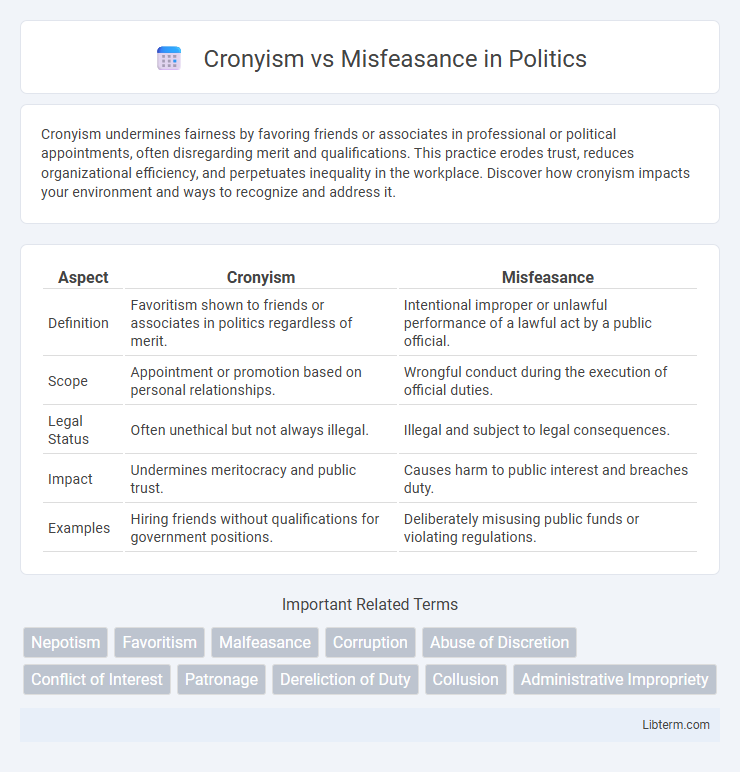Cronyism undermines fairness by favoring friends or associates in professional or political appointments, often disregarding merit and qualifications. This practice erodes trust, reduces organizational efficiency, and perpetuates inequality in the workplace. Discover how cronyism impacts your environment and ways to recognize and address it.
Table of Comparison
| Aspect | Cronyism | Misfeasance |
|---|---|---|
| Definition | Favoritism shown to friends or associates in politics regardless of merit. | Intentional improper or unlawful performance of a lawful act by a public official. |
| Scope | Appointment or promotion based on personal relationships. | Wrongful conduct during the execution of official duties. |
| Legal Status | Often unethical but not always illegal. | Illegal and subject to legal consequences. |
| Impact | Undermines meritocracy and public trust. | Causes harm to public interest and breaches duty. |
| Examples | Hiring friends without qualifications for government positions. | Deliberately misusing public funds or violating regulations. |
Understanding Cronyism: Definition and Examples
Cronyism refers to the practice of favoring friends, relatives, or associates in professional settings, often by granting them jobs or advantages without regard to their qualifications. This unethical behavior can undermine organizational integrity and lead to reduced efficiency and employee morale. Examples of cronyism include appointing unqualified family members to key management positions or awarding contracts to close associates regardless of merit.
Exploring Misfeasance: Meaning and Key Characteristics
Misfeasance refers to the improper or illegal performance of a lawful act, often by a public official or person in a position of trust, which results in harm or damage. Key characteristics include the deliberate or negligent execution of a duty, breach of fiduciary responsibility, and the presence of wrongdoing that negatively impacts individuals or organizations. Unlike cronyism, which involves favoritism based on personal relationships, misfeasance centers on the wrongful conduct in professional or official duties causing tangible harm.
Historical Background of Cronyism and Misfeasance
Cronyism, rooted in ancient societies, often emerged in political and economic systems where personal relationships influenced appointments and favors, notably seen in Renaissance Italy and early modern European courts. Misfeasance, with origins in English common law, historically pertains to the improper performance of lawful acts, evolving through judicial decisions addressing public office misconduct since the 19th century. Both concepts reflect longstanding challenges in governance, highlighting tensions between personal loyalty and legal accountability.
Key Differences Between Cronyism and Misfeasance
Cronyism involves favoritism shown to friends or associates, typically by giving them jobs or advantages without regard to merit, while misfeasance refers to the wrongful or unlawful exercise of lawful authority by a public official or agent. The key difference lies in cronyism's focus on personal relationships influencing decisions, whereas misfeasance emphasizes improper or negligent conduct in the execution of official duties. Cronyism undermines fairness in appointments, whereas misfeasance compromises the legitimacy and legality of administrative actions.
Legal Implications of Cronyism
Cronyism involves favoritism shown to friends or associates, often leading to unfair advantages in hiring or contracts, which may violate anti-corruption and public trust laws. Legal implications of cronyism include investigations for breach of fiduciary duty, conflicts of interest, and potential prosecution under statutes prohibiting nepotism and unethical conduct. Courts frequently assess whether decisions were made impartially, emphasizing transparency and adherence to statutory regulations to prevent abuse of power.
Legal Ramifications of Misfeasance
Misfeasance refers to the improper performance of a lawful act, leading to legal consequences including civil liability and potential damages for harm caused. Unlike cronyism, which involves favoritism without necessarily breaching legal duties, misfeasance incurs direct accountability under tort or contract law, often resulting in lawsuits or regulatory sanctions. Courts may impose penalties or require restitution to rectify the misuse of power or negligence implicated in misfeasance cases.
Impact on Public Sector and Governance
Cronyism undermines public sector integrity by prioritizing personal relationships over merit, leading to inefficient resource allocation and eroding public trust in governance. Misfeasance involves the improper or unlawful exercise of official duties, causing legal liabilities and weakening institutional accountability. Both practices diminish the effectiveness of public institutions and hinder transparent, fair governance essential for sustainable development.
Recognizing Cronyism in Organizations
Recognizing cronyism in organizations involves identifying favoritism where friends or associates receive unfair advantages in hiring, promotions, or contracts without merit-based evaluation. This practice undermines organizational integrity, leading to decreased morale and potential legal repercussions compared to misfeasance, which refers to the wrongful exercise of lawful authority causing harm. Monitoring transparent decision-making processes and implementing strict anti-corruption policies are essential for detecting and preventing cronyism.
Preventing Misfeasance in Corporate Environments
Preventing misfeasance in corporate environments requires strict governance policies, transparent decision-making processes, and robust internal controls to detect and address unethical conduct or violation of duties by company officers. Implementing comprehensive compliance programs, regular audits, and clear accountability mechanisms helps differentiate genuine managerial mistakes from intentional misfeasance. Training leadership in ethical standards alongside adopting whistleblower protections significantly reduces the risk of fiduciary breaches and promotes corporate integrity.
Strategies to Combat Both Cronyism and Misfeasance
Implementing transparent hiring and procurement processes reduces cronyism by promoting merit-based decisions, while strict enforcement of anti-corruption laws deters misfeasance through accountability. Regular audits and whistleblower protections encourage reporting and early detection of unethical behavior. Training programs on ethics and governance enhance organizational culture, ensuring sustained vigilance against both cronyism and misfeasance.
Cronyism Infographic

 libterm.com
libterm.com